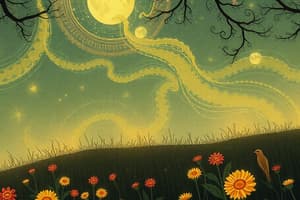Podcast
Questions and Answers
Балади - це форма поезії, яка виникла в ______
Балади - це форма поезії, яка виникла в ______
Європі
Метафора - це фігура мови, яка порівнює дві речі, не використовуючи слова "як" чи "як"
Метафора - це фігура мови, яка порівнює дві речі, не використовуючи слова "як" чи "як"
зірки
Алітерація - це повторення того ж звуку на початку слів у ______ чи рядку поезії
Алітерація - це повторення того ж звуку на початку слів у ______ чи рядку поезії
реченні
Поети використовують різні техніки для створення ______ реакції у читача
Поети використовують різні техніки для створення ______ реакції у читача
Персоніфікація - це надання людських рис або поведінки не живим речам або ______
Персоніфікація - це надання людських рис або поведінки не живим речам або ______
Поезія - це форма літератури, що використовує мову, щоб викликати ______, зображення та ідеї
Поезія - це форма літератури, що використовує мову, щоб викликати ______, зображення та ідеї
Поети використовують різні літературні засоби, щоб передати свої повідомлення, такі як метафори, порівняння, ______ та уособлення
Поети використовують різні літературні засоби, щоб передати свої повідомлення, такі як метафори, порівняння, ______ та уособлення
Сонет складається з 14 рядків і слідує певній ______ рифмування
Сонет складається з 14 рядків і слідує певній ______ рифмування
Хайку - це тип поезії, що походить з Японії та складається з трьох рядків з відліком 5-7-5 ______
Хайку - це тип поезії, що походить з Японії та складається з трьох рядків з відліком 5-7-5 ______
Вільний вірш - це форма поезії, яка не слідує певній схемі ______ або метру
Вільний вірш - це форма поезії, яка не слідує певній схемі ______ або метру
Flashcards are hidden until you start studying
Study Notes
Poetry in Literature
Poetry is a form of literature that uses language to evoke emotions, images, and ideas. It is often characterized by its use of rhythm, rhyme, and meter to create a musical effect. Poets use various literary devices to convey their messages, such as metaphors, similes, alliteration, and personification. Poetry can be divided into various genres, including sonnets, haiku, free verse, and ballads.
Sonnets
A sonnet is a form of poetry that originated in Italy in the 13th century. It consists of 14 lines and follows a specific rhyme scheme. There are two main types of sonnets: the Italian (Petrarchan) sonnet and the English (Shakespearean) sonnet. The Italian sonnet has an octave (eight lines) followed by a sestet (six lines), while the English sonnet has three quatrains (four lines each) followed by a couplet (two lines).
Haiku
Haiku is a type of poetry that originated in Japan. It consists of three lines with a 5-7-5 syllable count. Haiku often focuses on nature and the changing seasons. It emphasizes the use of imagery and the use of simple, concrete language.
Free Verse
Free verse is a form of poetry that does not follow a specific rhyme scheme or meter. It allows the poet to experiment with the structure of the poem and to use the rhythm of the language to create a musical effect. Free verse can be challenging to write because it requires a strong understanding of language and poetic technique.
Ballads
Ballads are a form of poetry that originated in Europe. They are usually sung to music and tell a story. Ballads often have a simple, repetitive structure and use a lot of imagery to convey the story. They can be about many different subjects, including love, war, and history.
Poetry and Literary Devices
Poets use various literary devices to create meaning and to evoke emotions in their readers. Some common literary devices in poetry include:
- Metaphor: A metaphor is a figure of speech that compares two things without using the words "like" or "as." For example, "Her eyes were stars" is a metaphor that compares the eyes to stars.
- Simile: A simile is a figure of speech that compares two things using the words "like" or "as." For example, "His eyes were like stars" is a simile that compares the eyes to stars.
- Alliteration: Alliteration is the repetition of the same sound at the beginning of words in a sentence or a line of poetry. For example, "Peter Piper picked a peck of pickled peppers" is an example of alliteration.
- Personification: Personification is the attribution of human characteristics or behaviors to non-human things or abstract concepts. For example, "The sun smiled down on the earth" is a personification that attributes the characteristic of smiling to the sun.
Poetry and Emotion
Poetry is often used to express emotions and to evoke emotions in the reader. Poets use various techniques to create a emotional response in the reader, such as:
- Imagery: Poets use vivid descriptions of sights, sounds, smells, and other sensory experiences to create a emotional response in the reader.
- Rhythm: The rhythm of a poem can create a emotional response in the reader. A fast-paced rhythm can create a sense of excitement or urgency, while a slow, steady rhythm can create a sense of calm or contemplation.
- Repetition: Repetition of words or phrases can create a emotional response in the reader. It can create a sense of urgency or emphasis, or it can create a sense of rhythm and musicality.
Conclusion
Poetry is a form of literature that uses language to evoke emotions, images, and ideas. It is often characterized by its use of rhythm, rhyme, and meter to create a musical effect. Poets use various literary devices to convey their messages, such as metaphors, similes, alliteration, and personification. Poetry can be divided into various genres, including sonnets, haiku, free verse, and ballads. Poetry is often used to express emotions and to evoke emotions in the reader, and it can be a powerful tool for exploring and understanding the human experience.
Studying That Suits You
Use AI to generate personalized quizzes and flashcards to suit your learning preferences.




